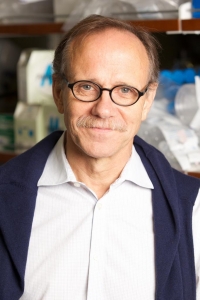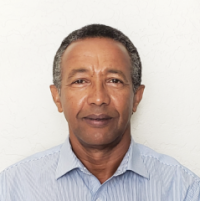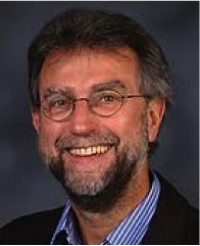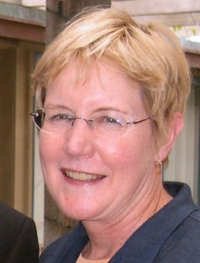Early Hominids
Biographical Sketches: Co-Chairs
University of California, Berkeley
My primary interests involve human evolution in all its dimensions. My research emphasizes fieldwork designed to acquire new data on early hominid skeletal biology, environmental context, and behavior. I have worked on hominids spanning the Pliocene and Pleistocene, from phylogenetic and functional perspectives. In parallel with this research, but in a more behavioral realm, I have investigated bone modification in the Pleistocene of the Old World and in the Holocene Southwest United States. Research underway includes fieldwork in Ethiopia and Turkey, and laboratory studies in both countries and in Berkeley.
The Laboratory for Human Evolutionary Studies, established by F.C. Howell, is an international center for research and training. The NSF-HOMINID program project "Researching Hominid Origins Initiative" was based in this laboratory. Former graduate students have done fieldwork and/or laboratory studies in China, France, Tanzania, Malawi, Kenya, Jordan, Turkey, and Ethiopia. Current undergraduate and graduate students as well as postdocs are studying vertebrate (including hominid) paleontology and human osteology.
Biographical Sketches: Speakers
National Museum of Ethiopia
Berhane Asfaw has spent over thirty years working on the earliest hominids in Africa's Great Rift Valley. His teams are widely credited with discovering fossils providing strong evidence for Africa as the cradle of humanity. The fossils unearthed range from about 6 million years ago to the most complete, earliest modern humans at 160,000 years ago.Dr. Asfaw served as the Director of the National Museum of Ethiopia, and member of the Center for Research and Conservation of Cultural Heritage in Ethiopia. After completing his undergraduate education in Addis Ababa in Geology, he received a fellowship from the Leakey Foundation to pursue a Ph.D. at the University of California, Berkeley. He currently lives in Ethiopia and he is a father of three sons and a daughter. He is currently the manager of the Rift Valley Research Service and a co-director of the Middle Awash Research Project.
Collège de France
Michel Brunet spent most of his childhood in a farm in Poitou (South-West of France). He entered the Sorbonne in Paris where he studied Natural Sciences and paleontology. He defended his doctorate in paleontology in 1966. Then he went to the University of Poitiers to study Paleogene mammals and completed his Natural Sciences State doctorate in 1975 (and became a tenured professor of paleontology in 1989). In 1976, his research concentrated on hominid paleontology in Afghanistan and Iraq. Due to the dangerous political situation in both countries Michel Brunet turned his attention to Africa where he decided to explore western Africa for ape and hominid fossils.
His first surveys took place in Cameroon in 1984 and in Chad in 1993, when he received a research permit from the Chad government to conduct excavations in the Lake Chad basin, today the Djurab Desert. He founded the Mission Paléoanthropologique Franco-Tchadienne (M.P.F.T.) to research the origin, the evolution and the environments of early hominids. In 1995, Michel Brunet described a new hominid dated to 3.5 My, Australopithecus bahrelghazali the first Australopithecine known west of the Rift Valley. He nicknamed this individual, “Abel,” in honor of the memory of a colleague and close friend who died during a field mission in Cameroon. In 2002 and 2005, Michel Brunet published the earliest hominid yet found (7 My): a nearly complete cranium, lower jaws and isolated teeth from Toros Menalla, Djurab desert (Northern Chad). The fossil, nicknamed, "Toumaï" (meaning “hope of life” in the local Goran language), was classified in Nature by Michel Brunet as: Sahelanthropus tchadensis.
More recently he has also led field surveys and diggings for fossil mammals and primates in Libya and Egypt (with the Al Fateh University of Tripoli and Cairo University).
Michel Brunet is currently Professor of the College de France, Chaire de Paleontologie humaine, in Paris, and a Member of the Institut International de Paleoprimatologie et Paleontologie humaine: evolution et paleoenvironnements (I.P.H.E.P.) UMR CNRS 6046 of the University of Poitiers.
Wits University
Ronald Clarke is a renowned Wits University palaeo-anthropologist who made great strides in world palaeontology in 1997 when he unearthed the first known complete Australopithecus skeleton, known as “Little Foot”. Clarke’s historic find is unique because it is the only complete adult Australopithecus skeleton known. However, its importance stems also from the fact that many elements of the find are themselves unique. These are that the discovery has produced the only complete skull of an adult Australopithecus, the only complete hand, complete arm and complete leg. Each one of these reveals a wealth of information about our ancestry, and taken together, provides unparalleled insights into our past. A long, painstaking process of careful excavation is releasing the skeleton from the concrete-like cave infill, and exciting information about our evolution has been revealed, as the bones are uncovered. Significant parts of “Little Foot” will soon be brought up to the sunlight into a world very different from that which it left, when it fell into the depths of the cavern 3.3 million years ago. E-mail: Kathleen.Kuman@wits.ac.za
Salk Institute for Biological Studies
Fred H. Gage is a professor in the Laboratory of Genetics and the past President (2018-2023) of the Salk Institute. He is an adjunct professor at UC San Diego, and emeritus Co-Director of CARTA. Dr. Gage concentrates on the adult central nervous system and unexpected plasticity and adaptability to environmental stimulation that remains throughout the life of all mammals. His work may lead to methods of replacing or enhancing brain and spinal cord tissues lost or damaged due to Neurodegenerative disease or trauma. Gage's lab showed that, contrary to accepted dogma, human beings are capable of growing new nerve cells throughout life. Small populations of immature nerve cells are found in the adult mammalian brain, a process called Neurogenesis. He is working to understand how these cells can be induced to become mature functioning nerve cells in the adult brain and spinal cord. They showed that environmental enrichment and physical exercise can enhance the growth of new brain cells and they are studying the underlying cellular and molecular mechanisms that may be harnessed to repair the aged and damaged brain and spinal cord. He is a member of the National Academy of Science and the Institute of Medicine.
UC San Diego
Pascal Gagneux is a Professor of Pathology and Anthropology at UC San Diego and serves as CARTA's Executive Co-Director. He is interested in the evolutionary mechanisms responsible for generating and maintaining primate molecular diversity. The Gagneux laboratory studies cell-surface molecules in closely related primates species. His focus is on glycans, the oligosaccharides attached to glycolipids and glycoproteins of the surfaces of every cell and also secreted into the extra-cellular matrix. His laboratory is exploring the roles of molecular diversity in protecting populations from pathogens as well as potential consequences for reproductive compatibility. Dr. Gagneux’s interest is in how glycan evolution is shaped by constraints from endogenous biochemistry and exogenous, pathogen-mediated natural selection, but could also have consequences for sexual selection. Dr. Gagneux has studied the behavioral ecology of wild chimpanzees in the Taï Forest, Ivory Coast, population genetics of West African chimpanzees, and differences in sialic acid biology between humans and great apes with special consideration of their differing pathogen regimes.
In 2011, while Associate Director of CARTA, Dr. Gagneux helped to establish a graduate specialization in Anthropogeny at UC San Diego. This wholly unique graduate specialization is offered through eight participating graduate programs in the social and natural sciences at UC San Diego.
Arizona State University
Yohannes Haile-Selassie is a professor in the School of Human Evolution and Social Change and director of the Institute of Human Origins at Arizona State University (ASU), in addition to serving on the CARTA External Advisory Board.
His research interest is understanding the paleobiology and paleoecology of early human ancestors based on the fossil record. He has made fossil discoveries that are significant in human origins research and leads an international multidisciplinary team that conducts fieldwork in the Afar Region of Ethiopia.
Yale University
Renowned palaeoanthropologist Andrew Hill died on September 12, 2015, at age 69, after a prolonged battle with cancer.
The Englishman was the J Clayton Stephenson professor of anthropology at Yale University, and a curator and head of the division of anthropology in the Yale Peabody Museum of Natural History.
Before coming to the famed Ivy League school in 1985 he had held research positions at the national museums of Kenya, the directorship at the International Louis Leakey Memorial Institute of African Prehistory, in Nairobi, as well as a research fellowship at Harvard University.
Since 1984, he had been involved in palaeontological research at fossil sites in Abu Dhabi’s Western Region that date back six to seven million years ago, from the Late Miocene period.
Together with Peter Whybrow, he organised the first international palaeontology conference on the Late Miocene faunas, geology and palaeoenvironments of Abu Dhabi in 1995.
The papers presented at this conference were published by Yale University Press in the renowned monograph Fossil Vertebrates of Arabia, in 1999.
Since 2006, he had renewed annual fieldwork activities in the Western Region, co-directing the Baynunah Palaeontology Project with his former PhD student, Dr Faysal Bibi, of the Berlin Natural History Museum, and myself.
Hill was born on June 6, 1946 at Huthwaite, a small village in Nottinghamshire, England. He completed his bachelor’s degree in geology in 1967 at Reading University UK, and his PhD at Bedford College, which is part of the University of London, in 1975.
Since 1968 he had carried out fieldwork in the UAE, Pakistan and eastern Africa, where for many years he directed the multidisciplinary Baringo Palaeontological Research Project.
In 1994, he received the Yale College-Lex Hixon ’63 prize for teaching excellence in the social sciences. In 2009, he was elected a fellow of the American Association for the Advancement of Science.
In 2012, he was recognised as a “notable alumnus” of Royal Holloway and New Bedford College.
He was interested in the whole range of human evolution but particularly in the environmental and ecological context in which it occurred.
During his long and distinguished career he published many important contributions relating to African studies, human evolution, environment, ecology, evolutionary theory, anthropology and archaeology.
His contribution was, however, not only in the form of scientific publications, but also took the form of discovering internationally important sites. The most famous took place in 1975 when he and a colleague were gleefully tossing elephant dung at each other at Laetoli, a hominid archaeological site in Tanzania.
As Hill dived out of the way, he stumbled on what turned out to be one of the wonders of prehistoric finds: a trail of hominid footprints about 3.6 million years old.
Until then, the oldest-known footprints of human ancestors were tens of thousands of years old. But this trail, about 25 metres long and preserved in volcanic ash, had been made by some of the first upright-walking hominids.
Hill’s work near Lake Baringo, Kenya, together with his wife, Sally McBrearty, an archaeologist, identified the first-known chimpanzee fossils (several teeth proving to be about 500,000 years old), shedding light on the evolutionary split between humans and chimps.
More recently he was part of the Baynunah palaeontology project team working in Al Gharbia, helping to discover important fossil sites and specimens.
Last year, a cheek tooth of a fossil monkey was discovered, a find that was later published in the journal Proceedings of the National Academy of Sciences. It proved to be the oldest guenon monkey known in the world, and the first record that guenons ever ranged outside Africa.
He is survived by his wife and companion of 35 years, Dr Sally McBrearty, who is from Glastonbury, Connecticut, in the US; his brother Stewart Hill, of Twickenham, UK; and his mother, May Hill, of Mansfield, UK.
http://www.thenational.ae/uae/andrew-hill-an-anthropologist-who-devoted-much-time-to-abu-dhabis-wilderness
Written by Dr Mark Jonathan Beech, the head of coastal heritage and palaeontology for Abu Dhabi Tourism and Culture Authority
UC San Diego
Margaret Schoeninger is Distinguished Professor Emerita of Anthropology at UC San Diego, a Research Archaeologist in the Glenn Black Laboratory of Archaeology at Indiana University, and Emerita Co-Director of CARTA. She has done fieldwork in North America, Mexico, Pakistan, India, Kenya, and Tanzania as well as laboratory research on carbon, nitrogen, and oxygen stable isotope ratio analysis in biological tissues and food component analysis of traditional foods. Her major interest is in the evolution of human diet particularly as it informs our understanding of the appearance and evolution of the human lineage.
Indiana University, Bloomington
Sileshi Semaw, research associate at Indiana University’s CRAFT (Center for Research into the Anthropological Foundations of Technology) and Stone Age Institute, is also director of the Gona Paleoanthropological Research Project in Afar, Ethiopia. In a recent issue of Nature, he reported that the project team has recovered more than 30 fossils—primarily jaws and teeth—from at least nine early humanlike individuals assigned to Ardipithecus ramidus. Scientists believe that A. ramidus is the first hominid genus to arise after the lineage split that led to chimpanzees and humans. The recent Gona discoveries suggest that A. ramidus walked on two feet and dwelled in woodland and grassland areas with lakes, swamps, and springs nearby. Semaw has made other important discoveries at Gona, including the oldest known stone tools (about 2.5 million years old) used by ancestral humans. “Our latest research has shown that Gona is a unique site preserving a wealth of information on the biological origin as well as the cultural beginnings and evolution of humankind,” says Semaw.
The University of Tokyo
Gen Suwa is a Japanese paleoanthropologist who has been working in Ethiopia with the Middle Awash team since 1990. He has specialized in the analysis of cranial and dental remains from ancient hominids since his graduate work at The University of California, Berkeley. Dr. Suwa works with CT scan technology and software to understand the inner structures of fossilized bones and teeth. Dr. Suwa recovered the first tooth of Ardipithecus ramidus in 1992 at Aramis, and has worked on the analysis and reconstruction of Ardipithecus ramidus for 17 years. He has co-directed the Konso and Chorora projects in Ethiopia. Dr. Suwa is a professor at the University Museum of Tokyo in Japan.












